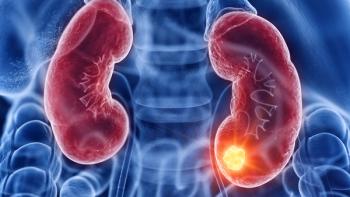
FDA Follow-Up: Utilizing Olaparib in Clinical Practice for BRCA+ High Risk Early Breast Cancer
Oncology Nursing News® speaks with the Charles E. Geyer, MD, FACP, an investigator with the phase 3 OlympiA trial to better understand the significance of olaparib’s approval and to determine what oncology nurses need to know about the new agent.
Olaparib (Lynparza) was
The regulatory decision was primarily supported by findings from the phase 3 OlympiA trial (NCT02032823), which demonstrated that olaparib yielded a 42% improvement in invasive disease-free survival (iDFS) compared with placebo. These results were deemed both statistically significant and clinically meaningful (HR, 0.58; 95% CI, 0.46-0.74; P <.0001).2,3
Furthermore,
Geyer, who is chief scientific officer of the National Surgical Adjuvant Breast and Bowel Project (NSABP) Foundation, and an investigator in the OlympiA trial, recently met with Oncology Nursing News® to discuss the significance of the approval and what the updated data signify for this patient population.
Oncology Nursing News®: Why are these findings and the recent FDA approval significant for this patient population?
Geyer: There has always been an extra burden [for this population]; these patients who find out they have a high-risk breast cancer and go through therapy know they have a persisting risk of recurrence, [because] they have this inherited germline mutation that predisposes them to further recurrence. That’s just been a lot to bear.
The thing that is nice about this therapy is [that it is] specific to the very thing that causes the cancer. Although there seems to be benefit from PARP inhibition for patients with ovarian cancer irrespective of their BRCA mutation status, in breast cancer, BRCA seems to really be necessary [to see a] benefit. This is a new additional therapy, and it works very differently than everything else, and we are seeing a clear, substantial additive benefit with it.
When you're talking about finishing chemotherapy, surgery, radiation, and now we're [recommending], an additional year of therapy, it is good to hear that it is as effective as it is, but it is also really good to hear that it seems to be really fairly well tolerated and that this benefit can be achieved without too much of a burden for the patient.
What is the optimal dosing and administration of olaparib?
The starting dose in the study was 300 milligrams twice a day. The medication comes in tablets, there are 150 milligram tablets that are a greenish color, and 100 milligram tablets, which are yellow. Patients start out by taking 2 green tablets twice a day.
Is there anything related to the safety profile of olaparib that nurses should be aware of?
The most common side effect is nausea; almost 60% of patients reported some degree of nausea. Mostly grade 1, but any grade [of nausea] is not pleasant when you're [taking the agent] twice a day, day after day, so we want to really prevent that. The good thing we saw on the OlympiA trial was that the nausea seemed to be most intense during that first month of therapy, and subsided.
[However], it is important to work with patients to help them understand that. Additionally, doctors on the study found that sometimes patients do not hear how important it is to take [olaparib] with food. It can be a light meal [or] a snack, but we do [stress the importance of] taking it with food. That is a hugely important message.
The other major consideration is anemia. The anemia can cause fatigue as it becomes more pronounced. It will be important for doctors or nurses to learn how we managed that in OlympiA: we were pretty conservative. If the hemoglobin dropped below 9.5, we said to stop the drug until it came back up. If the hemoglobin came back quickly, (within a week or 2), we [returned to the same dose]. If it took longer [than 1 or 2 weeks), we reduced the dose.
Sometimes hemoglobin can drop quick enough [that] patients get symptomatic and might require transfusions; about 6% of the patients required a blood transfusion, but only 2% required more than 1 transfusion. It is important [to monitor] complete blood counts carefully, and [understand] that it is okay to hold the drug.
Sometimes patients feel “I need to take it, I can take it, and I don't feel bad enough to stop it.” However, you don't want the hemoglobin to drop: [the treatment] is a marathon—[they take it] for a whole year, so we want to work to find the correct dose. That will be important to keep in mind.
What will future research efforts involving olaparib entail?
These drugs work by inhibiting PARP, which is part of our DNA repair systems. We know that patients with ovarian cancer who have received PARP inhibition sometimes experience problems like leukemia. That was part of the reason we specifically [enrolled] higher-risk patients. We did not know how patients with breast cancer would do long term.
Thus far, it has been very gratifying to see no difference between placebo and olaparib in this patient population [in developing this specific adverse event], but this remains an important part of the study. We are going to follow these patients for [another] 10 years. We are going to be getting more information about how well the drug works and [any] possible late effects.
However, right now, with this degree of benefit and the tolerability, olaparib warrants consideration [as a treatment option], and the FDA agrees.
References
- Lynparza approved in the US as adjuvant treatment for patients with germline BRCA-mutated HER2-negative high-risk early breast cancer. AstraZeneca. News release. March 11, 2022. Accessed March 23, 2022. https://bit.ly/3tQePcn
- Tutt ANJ, Garber JE, Kaufman B, et al. Adjuvant olaparib for patients with BRCA1- or BRCA2-mutated breast cancer. N Engl J Med. 2021;384(25):2394-2405. doi:10.1056/NEJMoa2105215
- Tutt A, Garber JE, Kaufman B, et al. OlympiA: a phase III, multicenter, randomized, placebo-controlled trial of adjuvant olaparib after (neo)adjuvant chemotherapy in patients with germline BRCA1/2 mutations and high-risk HER2-negative early breast cancer. J Clin Oncol. 2021;39(suppl 15):LBA1. doi:10.1200/JCO.2021.39.15_suppl.LBA1
- Lynparza (olaparib) reduced risk of death by 32% in patients with germline BRCA–mutated, HER2–negative high–risk early breast cancer in phase 3 OlympiA trial. Merck. News release. March 16, 2022. Accessed March 22, 2022. https://bit.ly/36ByYeb
Newsletter
Knowledge is power. Don’t miss the most recent breakthroughs in cancer care.
























































































